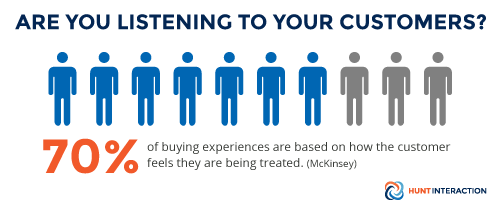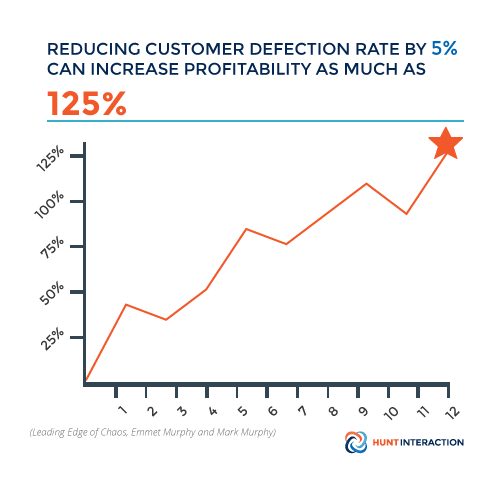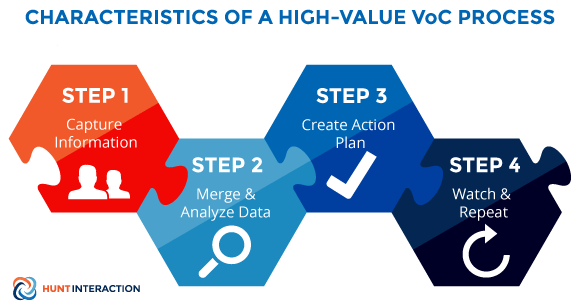You probably think you’ve got a good handle on what your customers think of your company and products with your current Voice of Customer program. You send out a regular survey, compile the responses, and look at the consolidated results. Good, right?
Whoa, hold up a second. Are you basing ALL of your customer feedback on a survey? You’re not alone, but there’s a better way to get a goldmine of legit, customer feedback that can change your company in the best of all possible ways.
What is a Voice of Customer Program?
A Voice of Customer (VoC) process is a systematic way of acquiring and directing a positive change in your company, all based on feedback from your customers. A trustworthy VoC process or program takes feedback from a variety of sources (some structured, some unstructured) and combines them to create actionable feedback.
Why Do You Want a VoC Program for Your Company?
Keeping your company relevant to your customers is essential to keeping your competition at bay, increasing customer loyalty and decreasing customer complaints. You know, the things that help keep the lights on, your P&L healthy, and your board happy.
Understanding your customers’ preferences as well as their buying patterns, allows you to respond to your customers in a way that means something to them and adds value to your bottom line. A VoC process gives you insights into what makes your customers happy and, also, what drives them away from you or even to your competition.

Common Pitfalls of VoC Processes
You have a VoC process in place, awesome! But are you making any one of these five critical mistakes?
1. You’re talking to the wrong customers
If you’ve identified the customers who are going to help you reach your goals why would you listen to customers who would drive your business into the ground? It’s worth the time and effort to focus on a group of customers who bring the biggest benefit to your company.
2. You’re asking the wrong questions
“How is your day going?” is a great opening question for a conversation but it won’t cut the mustard when it comes to reaching business goals. Dig deep and get real with your customers.
Don’t ignore the complaints. Criticism can be tough to hear, but it’s critical you suck it up and hear what your customers have to tell you - or outsource the dirty work to your VoC partner who won’t take complaints personally.
3. You’re subconsciously skewing your answers
We all have personal biases and those biases tend to be stronger when you’re intimately familiar with the company, processes, and products. Your bias becomes even more active when your personal paycheck is on the line.
If you're worried poor customer responses will impact the reputation of you or your team, or that your development team may react poorly to requests for change to an online ordering process, or even that your customer service team may get defensive, keeping these worries in the back of your mind may skew your results.
4. You aren’t distributing the data to the right people in your company.
Keeping your results and recommendations locked and siloed in your department won't help the business. You should share information about your customers with different departments in the company and have a process and regular schedule for distributing this information. Yes, your customer service team should be in the loop. Yes, your executive team should also be aware of the needs and desires of your customers.
5. You don’t act on the feedback.
Cross-functional teams are a blessing and a curse. They’re vital to discussing, prioritizing and implementing the critical feedback your customers are giving you. Assign an owner of your VoC program and hold them accountable for working with others outside their own department to implement suggestions made by your customers.
Good to Great: Steps to Improve Your VoC Program
It’s never fun to get bad news, but many of the most positive changes for a company can come from resolving customer complaints.

High-Value VoC programs include:
Information from a variety of sources.
Valuable VoC programs capture information from both internal and external sources. Customer feedback from Customer Service agents, surveys (although people tend to lie on surveys), online ordering attrition data, 1:1 interviews, etc.Merge and analyze captured data.
Data, especially from different sources and in large quantities, can be difficult to consolidate, but the best information lies in the amount of information. Evaluate combined recommendations against company goals and prioritized changes with key stakeholders. The best analysis ties back to individual customer segments to prioritize further the most significant changes.Action plan for implementation.
Saying you’ll get around to implementing critical pieces of feedback is easy to do. Biting the bullet and adding changes to the product or marketing roadmap (and getting the buy off to do it) is tougher. Key customer information isn’t going to do you any good sitting in a folder on some long-forgotten server, you have to act on customer feedback for it to be truly valuable.Watch, repeat, and compare over time.
Like so many other programs involving customers, this isn’t a one and done exercise. Customers needs and attitudes are always changing, humans are messy. Just as your quarterly and annual goals change, so do the needs, wants, and desires of your customers.

The Easier Path to Running a Voice of Customer Program
The list of things that need to get done in your business never stops growing. Sometimes it’s easier to bring in outside help to get your projects done (the number of fires that happen daily is enough to make you wear a fireman’s hat All. Day. Long.).
Finding a trusted partner to get your VoC process up and running can take some time. Every company is different - different goals, different staffing capabilities, different budgets, and your business deserves a VoC program to meet those unique characteristics.
Looking to up your customer intelligence game? Here are a few things to look for in a partner:
Availability.
Are you just a customer number or will you have the ability to ask questions as they come up and will your VoC team understand the gravity of your questions?Incorporates the “Voice of the Employee”.
Don’t forget about your employees as a source of information. Employees typically have more direct interaction with customers than you do, and while their feedback may be anecdotal, it does have a place in your VoC program. A VoC partner should generate enough trust among front line employees to gather their (sometimes) brutally honest feedback.Leverages existing information sources.
Your VoC partner should incorporate your existing information sources while helping improve overall quality. Information may live in software, automated reports, interviews, customer service phone calls or other manual information.Works with all employees, regardless of their level.
The CEO and the guy who works on the shipping dock both have valuable information and your VoC partner should create relationships with all employees at any level.Price.
You may not like to admit it but your budget is calling a lot of the shots when you pick a partner. Establish a starting budget as well as a stretch budget so you can work with the partner who brings demonstrated value to your company.Provides custom solutions.
A VoC partner should recommend timing, enhancements, clearly outline deliverables, and work with the unique aspects of your company, instead of shoving your program into a pre-determined, cookie-cutter package.Collaborates with you and your team.
Great VoC partners will work with your key stakeholders to understand goals and communicate benefits instead of just throwing a report at you and slinking back into their shells.
If you’re currently running a Voice of Customer program and need a fresh set of eyes to help you get closer to “customer enlightenment” shoot me an email or sign up for a free, 20-minute consultation and we'll have a conversation about your goals and what you want to get out of implementing a VoC process for your business.
